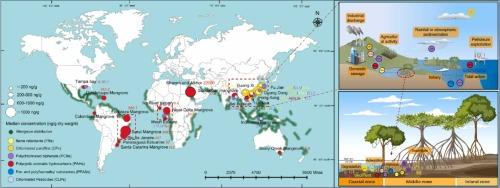全球红树林沉积物中有机污染物的发生、分布及生态风险
IF 11.3
1区 环境科学与生态学
Q1 ENGINEERING, ENVIRONMENTAL
引用次数: 0
摘要
红树林是热带和亚热带最重要的潮间带生态系统之一,具有较高的生产力和生物多样性。然而,红树林正日益受到人为有机污染物的威胁。虽然许多研究报告了红树林沉积物中有机污染物的存在,但对红树林生态系统中有机污染物的发生、分布和来源的全面综合仍然缺乏。为了弥补这些差距,研究人员根据全球25个红树林生态系统的724个沉积物样本的数据进行了系统审查,涵盖了212种有机污染物。结果表明,红树林沉积物中检测到的主要化合物为多环芳烃(PAHs)、多氯联苯(PCBs)、阻燃剂(FRs)、氯化农药(CLPs)、全氟烷基多氟烷基物质(PFASs)和氯化石蜡(CPs),浓度分别为9.37 ~ 2435 ng/g、0.39 ~ 165 ng/g、0.04 ~ 27 ng/g、0.12 ~ 31.32 ng/g、0.33 ~ 10.19 ng/g和262 ~ 404 ng/g。其中,多环芳烃(PAHs)和多氯联苯(PCBs)是主要的研究热点,而近年来对新出现的污染物(CPs和PFASs)的检测也越来越多。污染研究显示出显著的地理不平衡,在东南亚、西非和拉丁美洲等主要红树林丰富地区的研究在文献中仍然严重缺乏代表性。总有机碳含量和沉积物粒度等关键环境因子影响红树林沉积物中的污染物行为。进一步的污染源分析表明,有机污染物主要来源于工业废水、生活污水、石油和生物质燃烧、渔业活动和石油泄漏。此外,还对红树林有机污染的发生、分布和生态风险提出了重要的研究空白和建议。本文综述了红树林沉积物中有机污染物的发生、命运、生态风险、影响因素和建议,为科学家、决策者和环境管理者开发更有效的红树林生态系统恢复和保护技术提供了理论基础和有价值的参考。本文章由计算机程序翻译,如有差异,请以英文原文为准。

Occurrence, distribution, and ecological risks of organic pollutants in global mangrove sediments
Mangroves are one of the most important intertidal ecosystems in the tropics and sub-tropics, with high productivity and biodiversity. However, mangroves are increasingly threatened by anthropogenic organic pollutants. While numerous studies have reported the presence of organic pollutants in mangrove sediments, a comprehensive global synthesis focusing on the occurrence, distribution, and sources of organic pollutants in mangrove ecosystems remains lacking. To bridge these gaps, a systematic review was conducted based on data from 724 sediment samples in 25 mangrove ecosystems worldwide, covering 212 organic pollutants. The results showed that polycyclic aromatic hydrocarbons (PAHs), polychlorinated biphenyls (PCBs), flame retardants (FRs), chlorinated pesticides (CLPs), perfluoroalkyl polyfluoroalkyl substances (PFASs), and chlorinated paraffins (CPs) were the main compounds detected in mangrove sediments, with concentrations of 9.37–2435 ng/g, 0.39–165 ng/g, 0.04–27 ng/g, 0.12–31.32 ng/g, 0.33–10.19 ng/g and 269–404 ng/g, respectively. Among all compounds, PAHs and PCBs were the predominant researches focus, while efforts toward detecting emerging pollutants (CPs and PFASs) have increased in recent years. Pollution research showed significant geographical imbalances, with studies in major mangrove-rich regions such as Southeast Asia, West Africa, and Latin America remaining critically underrepresented in the literature. Key environmental factors, such as the total organic carbon content and sediment grain size, influence pollutant behavior in mangrove sediments. Further source analysis showed that organic pollutants originated mainly from industrial wastewater, domestic sewage, the combustion of petroleum and biomass, fishing activities, and petroleum spillage. Moreover, critical research gaps and recommendations for future studies on the occurrence, distribution, and ecological risk of organic pollution in mangroves were proposed. To the best of our knowledge, this review provides the occurrence, fate, ecological risks, influencing factors and recommendations of organic pollutants in mangrove sediment, offering a theoretical foundation and valuable reference for scientists, policymakers, and environmental managers aiming to develop more effective restoration and conservation techniques for mangrove ecosystems.
求助全文
通过发布文献求助,成功后即可免费获取论文全文。
去求助
来源期刊

Journal of Hazardous Materials
工程技术-工程:环境
CiteScore
25.40
自引率
5.90%
发文量
3059
审稿时长
58 days
期刊介绍:
The Journal of Hazardous Materials serves as a global platform for promoting cutting-edge research in the field of Environmental Science and Engineering. Our publication features a wide range of articles, including full-length research papers, review articles, and perspectives, with the aim of enhancing our understanding of the dangers and risks associated with various materials concerning public health and the environment. It is important to note that the term "environmental contaminants" refers specifically to substances that pose hazardous effects through contamination, while excluding those that do not have such impacts on the environment or human health. Moreover, we emphasize the distinction between wastes and hazardous materials in order to provide further clarity on the scope of the journal. We have a keen interest in exploring specific compounds and microbial agents that have adverse effects on the environment.
 求助内容:
求助内容: 应助结果提醒方式:
应助结果提醒方式:


